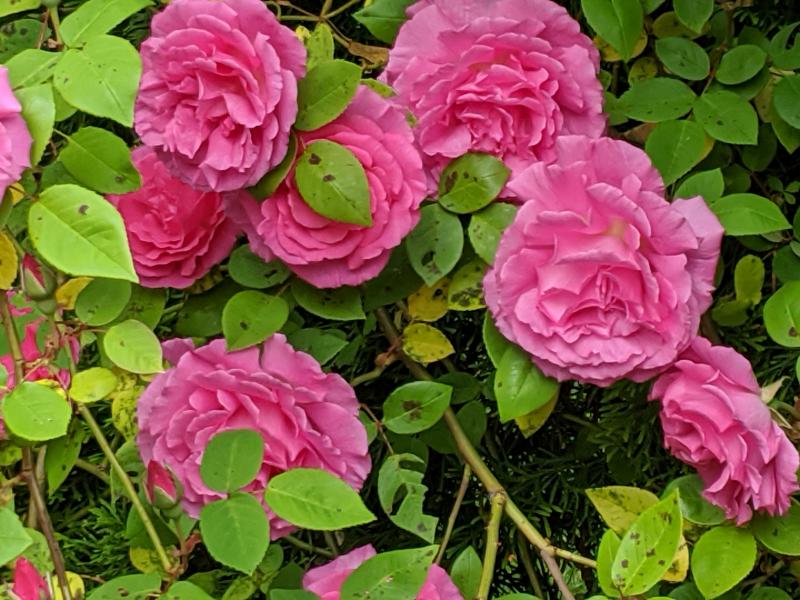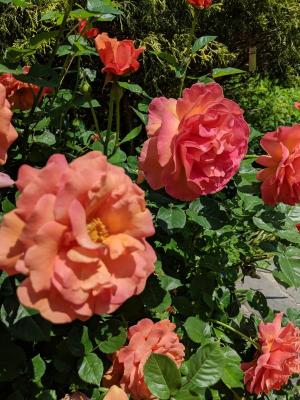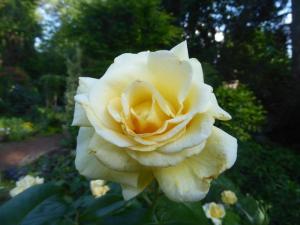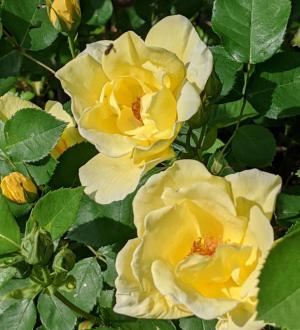Roses can be tough to grow, especially in the Cape Region with its hot, humid summers.
Most ornamental roses like cooler weather best. They are vulnerable to diseases when grown in high temperatures and high humidity, which enable fungal growth such as the dreaded Black Spot. Gardeners can grow some roses without pesticides, if they have sun, prepare soil properly and choose the tested best varieties for the area. Mill Pond Garden can provide such professional gardening and plant information.
A botanical garden or professional horticultural garden such as Mill Pond Garden can provide advice and examples on what plants work well in their region. Guided by a modern commitment to use as few pesticides as possible and none that are toxic to humans and wildlife in general, it prefers to only recommend plants that do well locally without toxic pesticides.
For any roses, the requirements are at least seven hours of sun, good drainage, lots of compost mixed in the soil in a large, well-prepared hole, horse manure, kelp, Epsom salts, and feeding every two weeks with an organic rose fertilizer. Roses are heavy feeders, yet few people do more than a spring fertilization. Many gardeners might succeed if they fed their roses more often and with better-quality items. Mill Pond Garden recommends some granular organic fertilizers like the Espoma brand and others, rather than spray-on or granular chemical ones, which can kill beneficial microbes that help maintain plant health.
Roses should be fertilized at planting, late winter, early spring, and then every two weeks through late August. For each rose, allow a few tablespoons of Epsom salts, magnesium sulfate, sprinkled over the root zone. Use horse manure in the hole at planting, then again a couple shovels full as top dressing in late winter, early spring and mid-August. Give a handful of powdered kelp at each of those manuring times, or a spray of liquid kelp extract on foliage. Kelp has powerful absorbable growth hormones, and compounds that destroy harmful bacteria, fungi, and other plant pathogens. Use a couple handfuls per rose of a granular organic rose food like Espoma’s Rose Tone or its equivalent, an all-purpose acidic formula for feeding steadily. Boost the effect each time with a couple tablespoons of Espoma Biotone with beneficial microbes to get the work going fast. Mill Pond Garden has no connection to Espoma, but its gardeners have tested their products thoroughly and they are available to the public in many different garden stores.
The ideal planting of a rose, in a sunny, well-drained spot, should begin with a 5-gallon bucket of horse manure dug into the soil in a hole at least two feet across and 18 inches deep. The other key ingredient at planting is four shovels of peat moss, a very acidic medium. Roses love acid soil, so leaving out the peat moss will produce a stunted plant unable to fight back against problems.
Some other maintenance tips are important. Clean up dropped leaves at end of every season and dispose of them in the trash so they don’t infect new growth with Black Spot disease. For repeat bloomers, prune back about a foot after each wave of blooming. Prune roses severely in February to a height of two feet for shrubs (not climbers). Remove dead canes and gnarly old canes which lose their vigor. For climbing roses, prune dead and very old canes only.
The garden’s list of reliable performing roses is very short. Roses are grouped by type – Tea, Floribunda, Shrub, Climber, Bourbon, Noisette, Cabbage, and more. However, the genetic background of each type is varied, and each specific cultivar name may have a complicated genetic and breeding background.
One guide for choosing roses is the All America Rose Selection, a nonprofit organization that evaluates rose varieties for performance nationwide. Its yearly AARS winners are beautiful and exceptional roses for the American home gardener, and Mill Pond Garden has tested most of them locally. Since Cape Region gardens often have part shade, that narrows the selections.
The best is a fragrant floribunda, Rosa Easy Does It, the AARS 2010 Rose of the Year, large and beautiful, heavy blooming with many petals, and changeable color from dark orange buds to a mango pastel color. It grows to five feet high by three feet wide. Second good choice is Rosa At Last, a creamy-orange, large-flowered fragrant floribunda growing to four feet by three feet, a generous continuous bloomer. The third good choice is the fragrant, pale-yellow, large-flowered Rosa Julia Child, also a floribunda.
The two most favored climbing roses are the thornless Rosa Zephirine Drouhin, a large-flowered, many-petaled, abundant pink antique Bourbon Rose that grows to about 10 feet, more shade-tolerant than most roses; and the tough Wichurana Rambler Rosa New Dawn, a big, pale-pink climber to 15 feet. Other good climbers that are slightly more disease-prone include the yellow Rosa Golden Showers and the red Rosa Blaze Improved. Growers must be patient, as climbing roses are slower to establish themselves than shrub-type roses.
Left out were roses with defects such as too thorny, too large, too few petals and insufficient disease resistance. This includes Knock Out Roses, which are good for landscape show, but up close are uninteresting individual roses with no fragrance. Their virtue is their abundant bloom.
The rose is the queen of the garden. The best have great beauty, fragrance and abundance. The peak of bloom for roses here is mid-May to early June, though many repeat bloom through the summer and may have a lesser second flush in late September.
For more information, go to www.millpondgarden.com.




















































